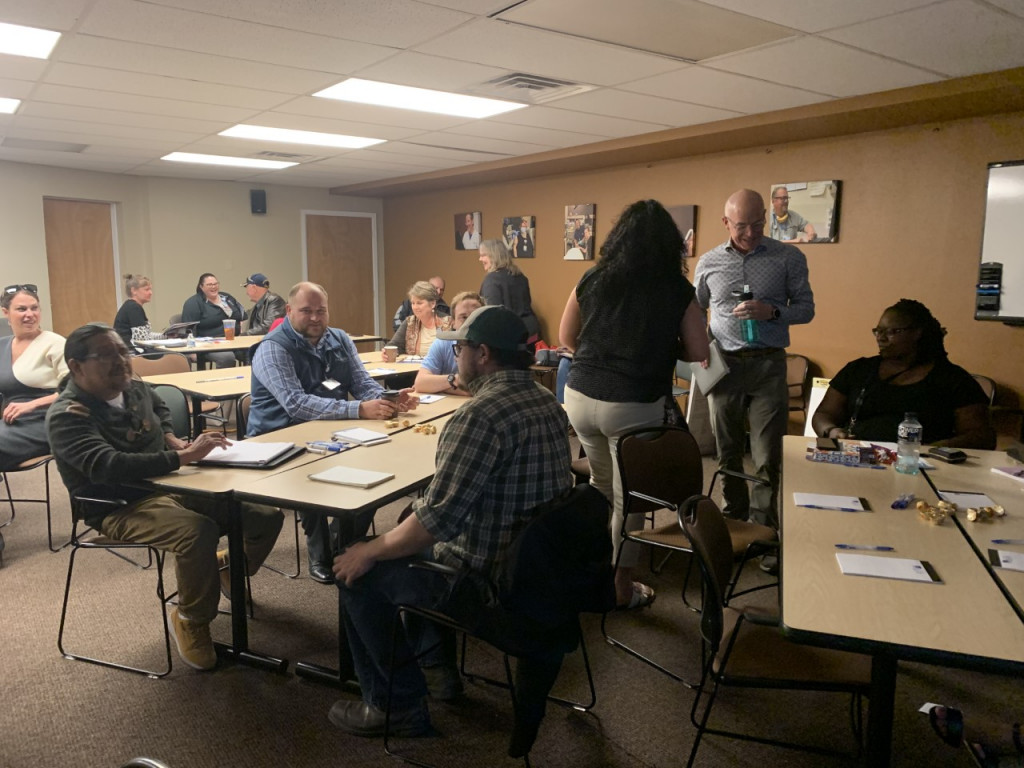Three areas identified as significant issues, needs in SLV Health Community Needs Assessment

ALAMOSA – Substance abuse. Mental Health. Chronic illness.
Those are the top three issues facing communities and top three needs in health care services for people living in the San Luis Valley, according to data collected, analyzed and presented to a group of roughly 40 – 50 people last week.
Emily Santich, who works for the Colorado Health Institute (CHI), shared the information during the third part of a Community Health Needs Assessment (CNHA) conducted by SLV Health with the assistance of CHI.The assessment is required of all non-profit hospitals by the Affordable Care Act, must be conducted every three years. This is SLV Health’s fourth such assessment, with the first conducted in 2013.
The assessment process initially kicked off with a gathering in early April where SLV Health managers and executive staff joined representatives of local agencies and service providers, health care and social service professionals, leaders with the city and county plus other civic leaders and advocates to discuss the broad topic of community health.
That meeting was followed with a written survey sent out to the community asking the same questions. How would people rate the San Luis Valley in terms of personal health? What are the top issues facing communities in the Valley? What are the greatest needs? There were also more service delivery related questions, such as how easy is it to get an appointment; how easy is it to access needed services, such as dental services, behavioral or mental health care or specialty care; and what is the greatest barrier to receiving care.
The third part of the three part assessment was conducted last week when the results of both the meeting and survey were shared.
Of those who responded to the survey, 77% said that substance abuse (both legal and illegal substances) was the greatest issue facing communities in the valley and 60% identified behavioral and mental health as the greatest issue. 59% of respondents said that chronic illnesses (obesity, diabetes, heart disease) presented the greatest issues with suicide ranking fourth.
Substance abuse and behavioral and mental health concerns were also reflected as the greatest needs facing communities along with issues related to child care and social services such a housing and food security.
The areas that surfaced as significant are not new to SLV Health as previous assessments have revealed similar concerns, but results from previous assessments indicated advancement.
“We were making progress,” says Donna Wehe, director of communications with SLV Health, “but then the pandemic hit and we’ve seen these areas re-emerge as significant concerns.”
The progress Wehe refers to was reflected in information shared by Chris Hettinger-Hunt, Chief of Operations with SLV Health, who reviewed with the group what progress had been made in the past three years to meet areas previously defined as top priorities.
Since 2019, SLV Health has made deliberate efforts to integrate both mental health services and substance abuse services into their clinic and hospital operations. With the implementation of the “Zero Suicide Initiative”, there has been significant staff training to increase general awareness around statements that may signal a response. In terms of substance abuse, SLV Health is now offering medicated assisted treatment-focused care coordination.
Even though SLV Health is largely considered to be the hub of health care delivery in the valley, ongoing and long-term treatment for mental health and substance abuse issues falls more within the scope of other service providers in the San Luis Valley. Toward that end, Hettinger-Hunt discussed how SLV Health has focused on growing their collaboration with both community partners in the Valley while also developing new and existing relationships with service providers outside of the valley, especially those providers who offer inpatient care and treatment.
Other progress included areas that, while not specifically listed as priorities in this most recent assessment, support the overall efficacy of health care operations serving patients. Hettinger-Hunt mentioned the ability to transport patients via helicopter with a helipad now located on hospital property; extensive outreach during the pandemic with triage, information hotlines, testing and vaccine clinics; increased education on chronic illness management plus focused efforts on healthy eating and access to healthy foods; more than a half million dollars devoted to (as the largest employer in the valley) salaries of hospital employees as well as opportunities for additional training to lead toward potential career advancement; and a visible, ongoing effort at strong care coordination for patients and primary care providers plus those receiving services from specialists.
One concern was brought up by a participant related to inadequate access to “culturally competent care”, including Spanish speaking medical and mental health professionals. That need was both recognized and echoed by CEO Konnie Martin who said providers had acknowledged the same challenge.
“We share in that struggle,” Martin said, “and share in the goal to make that more available to the community.”
In looking at the whole picture, Santich saw a congruence to what the data revealed, suggesting the assessment had highlighted areas that were both valid and relevant.
That sense was also reflected in comments from those individuals in attendance, including executive staff with the city who confirmed they had seen the same issues raised among their employees.
Community member Matias Francisco Matias added that the impact of the pandemic and current financial stressors experienced by many may also contribute to mental and behavioral health issues re-emerging as a widespread concern.



